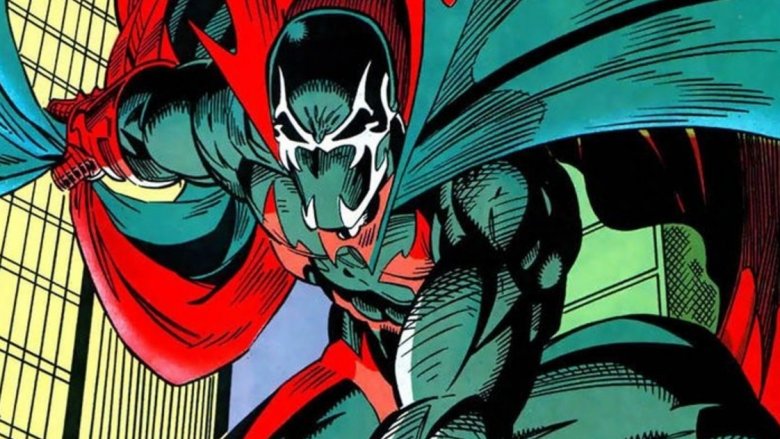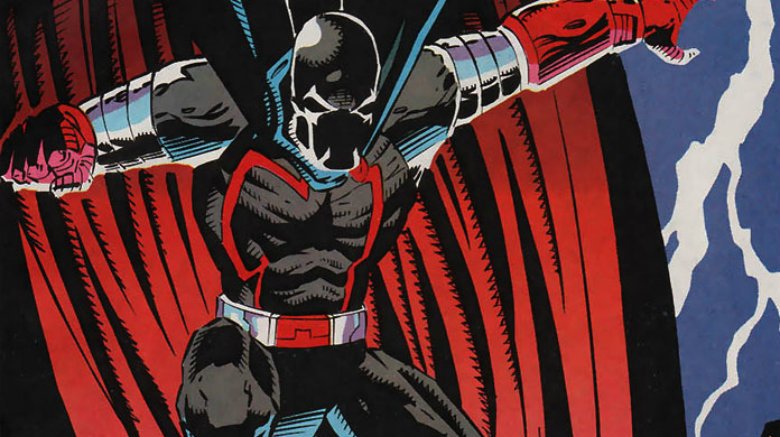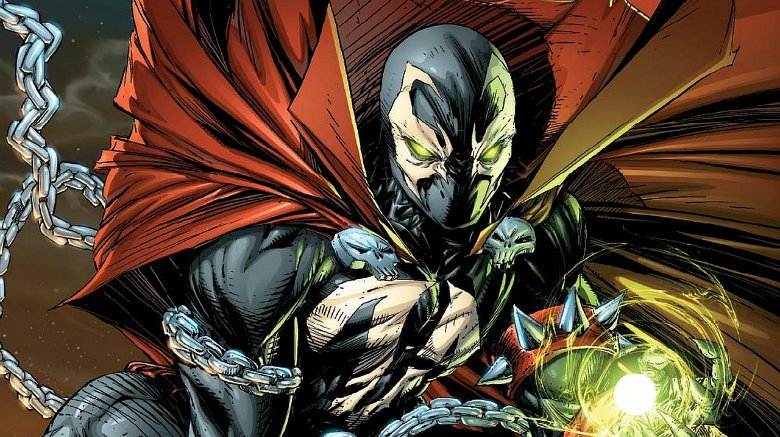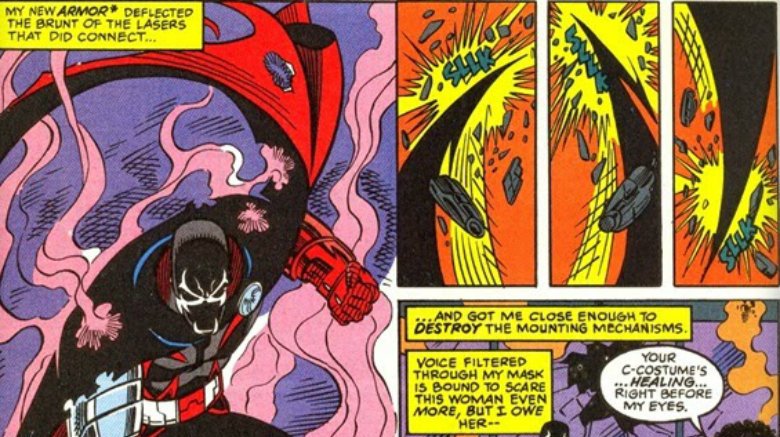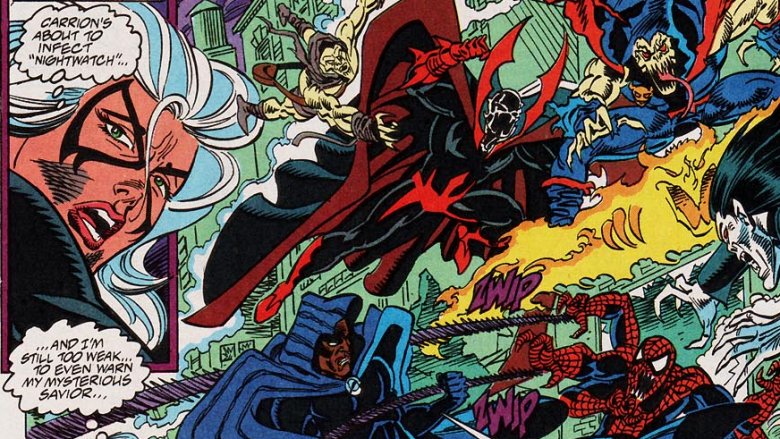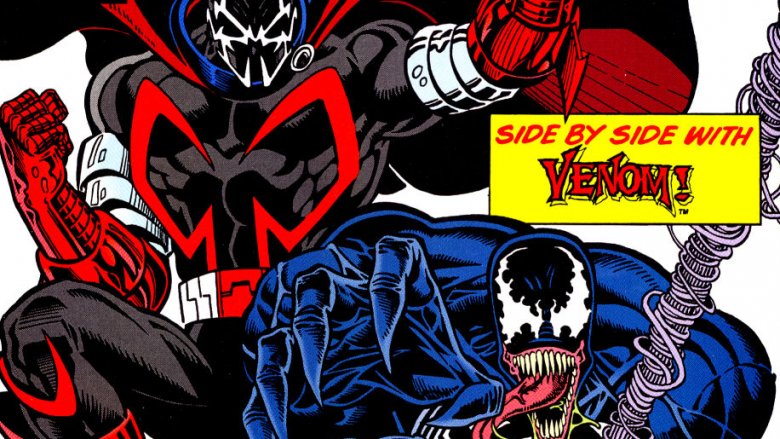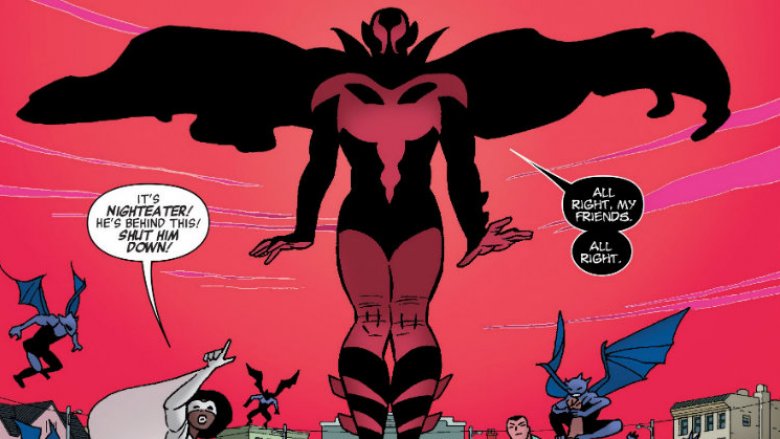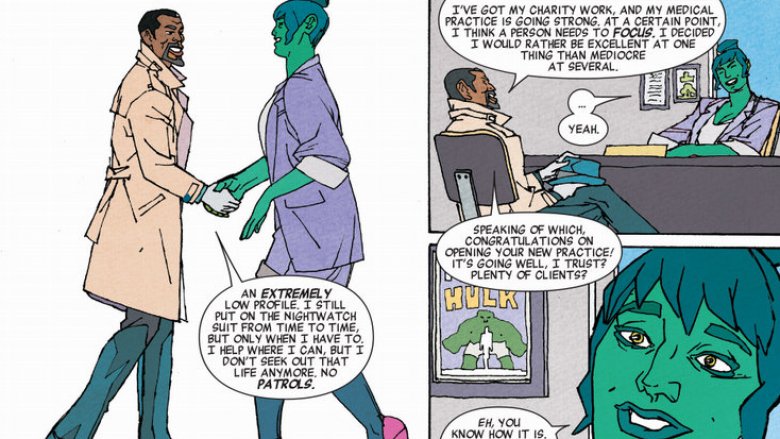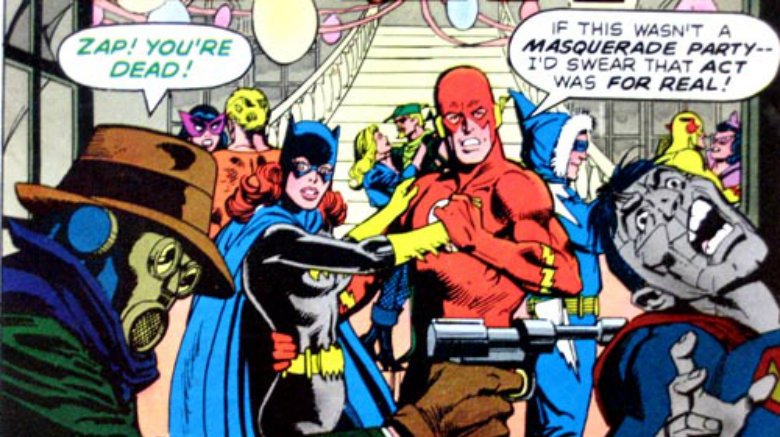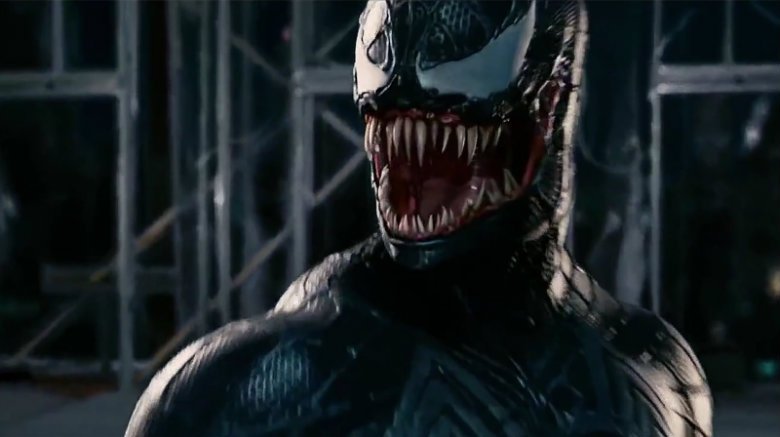The Untold Truth Of Nightwatch
Peter Parker may not work with an official sidekick, but over the years, your friendly neighborhood Spider-Man has fought crime with a bunch of his own super-powered friends, including members of the X-Men and the Avengers. While these allies are famous heroes in their own right, other lesser known characters have also populated the pages of Spider-Man's numerous titles — and some are now set to star in their very own movies, becoming household names in the process.
Ever since The Amazing Spider-Man 2 tried to plant the seeds of a shared Spidey Universe to rival the MCU, Sony have been eager to launch their own spinoff films. Venom was chosen to kickstart a new take on the Spider-Man franchise, with plans for it to be followed by Silver & Black, starring Black Cat and Silver Sable together onscreen for the first time. Plans are also afoot for a solo movie starring the Marvel character Nightwatch, but even diehard comic book fans might need a refresher about this long-forgotten character. Join us as we reveal the untold truth of Marvel's Nightwatch.
Bizarre origins
Radioactive spider bites are a far cry from the norm, but Spider-Man's origin story is still remarkably tame compared to the outlandish debut of Nightwatch, who gained his powers through thoroughly convoluted means.
In February 1993, Doctor Kevin Trench made his comic book debut in Web of Spider-Man #97, the pages of which found him watching a costumed man die fighting terrorists who wore cloaking devices. Upon unmasking the corpse, Trench discovered that the vigilante was in fact an older version of himself — which understandably freaked him out. To escape this fate, Trench took the costume and retreated to a deserted island, figuring that this would somehow prevent his death in the future.
However, it wasn't long before a criminal named Alfredo Morelli got his grubby hands on one of the costume's gloves, forcing Trench to come out of isolation and deal with the threat he posed. Naturally, he eventually decided to embrace the gifts the costume gave him and investigate its origins under the superhero guise of Nightwatch. Reasoning that he couldn't avoid his destiny, Trench ended up fighting alongside the likes of Spider-Man to protect his city from evildoers.
Is Nightwatch just Spawn 2.0?
Marvel and DC have been in competition for decades, and over the years, the two rivals have often drawn utterly obvious inspiration from each other. Classic examples include the striking similarities between Deadpool and Deathstroke as well as Tigra and Cheetah — but Marvel may have been inspired by a different comic book company for once with the creation of Nightwatch.
In May 1992, the comic book industry was changed forever when Todd McFarlane created the anti-hero Spawn for Image Comics, heralding a new age of "gritty" superheroes. Nightwatch was created not long after McFarlane left Marvel — and the parallels between this character and Spawn are too numerous to just be a coincidence.
Not only do Spawn and Nightwatch look incredibly similar, but the two heroes are both African-American, they both died in their origin stories, and they both also use a kind of shape-shifting cape as the basis for their powers. Given that less than a year passed after the debut of Spawn before Nightwatch was created, it's easy to see why people may think that the character of Doctor Kevin Trench is a ripoff.
A familiar power set
Whether or not you believe that Nightwatch was inspired by Spawn, it's hard to deny that his power set is somewhat similar to Todd McFarlane's creation. Both vigilantes possess superhuman strength, agility, and reflexes that are enhanced further by the shape-shifting capabilities of their capes. However, the two differ in the nature of these abilities.
While Spawn's power is drawn from the literal depths of hell, Nightwatch's costume is comprised of nanites that can self-replicate and respond to his subconscious thought processes. Not only can Nightwatch's outfit repair itself, but it can become more durable in order to protect Trench from harm and even possesses gliding capabilities close to flight. Shortly after his debut, Trench's abilities were enhanced further thanks to technology that made the suit more durable and metallic. Over the years, Marvel's Iron Man has also worn suits that respond to his thoughts in this way, but the difference here is that Tony Stark invented his armor, while Nightwatch obtained his from his older self thanks to a mind-bending time paradox.
Nightwatch's other Marvel Comics crossovers
Nightwatch might not be on the superhero A-list just yet, but Spidey's occasional ally fought alongside some of the best heroes that Marvel has to offer during the Maximum Carnage crossover published in 1993.
Comprised of 14 issues, the storyline saw Spider-Man, Venom, and a number of other heroes face off against Carnage and his own team of supervillains as they set out to devastate New York City on a villainous rampage. Alongside Spidey, Nightwatch teamed up with a vast array of heroes to protect the city, including the likes of Captain America, Black Cat, Cloak and Dagger, Iron Fist, Deathlok, Morbius, and Firestar.
It's not much of a spoiler to reveal that Nightwatch and his allies saved the day, but the most interesting aspect of this crossover was the moral tension between Venom and Spider-Man, who argued over the fate of Carnage and whether he should be stopped at all costs.
A short-lived solo run
Exactly a year after Trench first donned the Nightwatch costume in Web of Spider-Man #99, the super-powered vigilante became the star of his own solo title in April 1994. Nightwatch's comic book started with our hero's quest to discover the origins of his costume; a few months later, Venom guest-starred to boost sales. Unfortunately, the story didn't click with readers, and Nightwatch was canceled just one year later with issue #12, "The Exile's Return," in March of 1995.
As if that wasn't bad enough, Marvel then decided to kill Nightwatch off completely in December 1996 during the "Clone Saga" crossover that ran across each of the company's Spidey-related titles. Written by Glen Herdling, Spider-Man Unlimited Vol. 1 #14 pitted Spider-Man against the mastermind of the Great Game where one of his allies would meet their untimely end. While Rocket Racer, Cardiac and Prowler all faced danger, Nightwatch was the one who ultimately lost his life to the hands of Polestar. Using his magnetic abilities, the mercenary peeled away Trench's costume long enough for another villain called El Toro Negro to shoot him between the eyes. But don't feel too bad for Nightwatch: as is so often the case in comics, this death didn't last forever.
A secret past
In most media, the death of a character is typically permanent, but as any Marvel fan knows, this is no obstacle for superheroes, who are resurrected all the time. However, the return of Nightwatch was somewhat stranger than usual, even by comic book standards.
Almost 20 years after his death in 1996, Nightwatch appeared in the pages of She-Hulk Vol. 3 #12, where readers discovered that Kevin Trench originally started out as a superhero called Nighteater. The 2015 issue explained how Trench realized villains never win, and decided to become a hero instead. To do this, Nighteater engineered a spell with the help of Doctor Druid, Shocker and Vibro, altering reality to create a new timeline where he was perceived as a hero. She-Hulk, Tigra, Captain Marvel and Wyatt Wingfoot originally tried to stop him, but the group failed; because of this, the crimes of Nighteater were forgotten by most of the universe.
Are any of the previous Nightwatch stories even true now? It's unclear when this spell took place, exactly, so the entire history of Nightwatch in Marvel Comics is now suspect — aside from this one appearance in the pages of She-Hulk.
Nightwatch's reckoning
Before his evil past was uncovered, Trench approached She-Hulk about a lawsuit filed by a civilian who somehow avoided the effects of the spell. It turned out that Trench's death was greatly exaggerated and in truth, he was alive and well, sparingly using his powers while working at a medical practice and doing charity work.
When he met She-Hulk at her practice, Nightwatch ended up using his abilities to fight back against grotesque monsters who suddenly attacked. Afterwards, Trench told She-Hulk that he'd spread the word about her new practice — but that all fell apart when She-Hulk discovered that Trench had been trying to prevent her from investigating his villainous past as Nighteater.
Nightwatch was subsequently brought to justice for covering up his previous crimes, and that's where his situation currently lies within Marvel Comics continuity, although it would hardly be surprising if the character is brought back to prominence again in the lead up to his cinematic debut.
An impressive comics pedigree
While inker Derek Yaniger only worked on Web of Spider-Man for four issues before moving onto the likes of Hellraiser and Transformers, the writer and artist who helped create Nightwatch have both been involved in huge comic book storylines over the past few decades.
In the '90s, writer Terry Kavanagh penned a number of Spidey stories, including the Clone Saga that originally killed off Nightwatch, and he's also responsible for creating the Spider-Armor that Marvel used back in the day to help sell merchandise. Artist Alex Saviuk has worked for both Marvel and DC over the years, drawing a number of their most prominent heroes. Most notably, Saviuk drew The Flash #275 in July 1979, which just so happens to be the issue in which Iris West Allen was first killed at a masquerade ball, subsequently inspiring the season 3 arc of The Flash on TV.
A promising movie team
Legendary director Spike Lee is usually known for the biting social commentary of his indie dramas, so it may have come as something of a surprise when it was announced that he'd signed on to direct the Nightwatch movie for Sony Pictures. The project is still in the early stages, but Lee has built an incredible legacy of African-American cinema that could make him the ideal person to create the first black superhero for Sony's new franchise.
Lee will helm a script written by Cheo Hodari Coker, who was the showrunner on Season 1 of Luke Cage, so someone with superhero expertise will be involved in the project. Overseeing the development is Sony executive vice president Palak Patel, who is in charge of the entire shared Spider-Man universe. Before Nightwatch is released, his attention will be focused on Venom — due out October 5, 2018 — as well as the pending Silver & Black movie, which is working its way through script development with director Gina Prince-Bythewood, who's also involved in the Marvel TV series Cloak & Dagger, at the helm.
Future movie crossovers
As Sony takes the first steps toward building a cinematic universe around Spider-Man, it's extremely likely that their characters will interact further down the line. While Sony plans to give each movie an individual feel and tone, it would be disappointing if Nightwatch don't cross over with Venom and other Spidey-related characters too, including Silver Sable, Black Cat, and perhaps even Kraven the Hunter. Columbia Pictures president Sanford Panitch has already hinted that future Venom sequels would be the first to take this approach. Given that Venom and Nightwatch have worked together previously in the comics, there's some precedence for this team-up in particular.
Of course, this all depends on how successful the first few movies in the franchise turn out to be. If Venom or Silver & Black fail at the box office, then these crossovers — or even the possibility of a solo Nightwatch film in the first place — may quickly crumble. However, if the shared Spidey Universe does go ahead past the initial stages, then it wouldn't be surprising at all if Sony decides to adapt a crossover event from the comics — such as the previously mentioned Maximum Carnage storyline.
